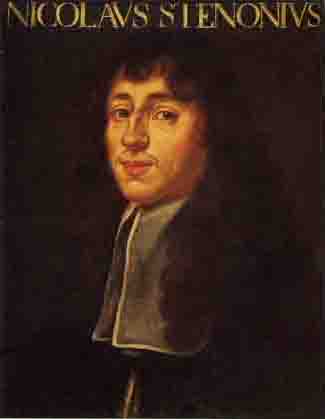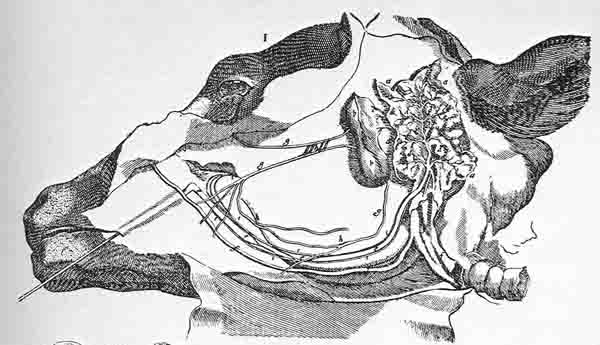
|
ニールス ステンセン って誰? 1638年にデンマークのコペンハーゲンで生まれた科学者です。18歳から医学の勉強をバルトリン教授(解剖学者、最初の欧州医学雑誌の創設者)の指導の下に始めまました。しかし、スエーデンとデンマークとの戦争が激しくなり1660年アムステルダムに移りました。当時、口の中に出てくる唾液は脳から老廃物が流れ込むと信じられていましたが、ステンセンは牛などの動物の頭部を解剖して口の中にたまる液体がどこから出てくるのかを辿ってゆきました。その結果、唾液は臓器(組織の塊、耳下腺と名付けられます)から分泌されていました。このことは唾液腺の発見にとどまらず、分泌線の発見となり、人類は初めて体の中に腺という水分を作り出す臓器があることを知りました。ステンセンの名は耳下腺から分泌された唾液を口腔に導く導管につけられています。その後、ライデン(オランダ)、パリ、フィレンツエなどヨーロッパの大学で、結晶学なども含む多くの自然科学の研究を繰り広げました。彼の博愛精神により、親交のあったメデイチ家からカソリックの枢機卿に推挙され(1674)、1676プロテスタントの国ドイツに布教に赴きます。1686年死亡するまで布教に勤めましたが、死後遺体はフィレンツエのメデイチ家の墓所のあるローレンツオ教会の礼拝所に安置されています(ミケランジェロ作彫刻朝、夜、夕暮、曙で有名)。彼の肖像画は聖職者としてのものが残っていますが、上の肖像画は科学者としてのステンセンを不明の画家が描いたものでウフィッツイ美術館に所蔵されています。下の図はライデン大学で1661年に印刷されたステンセンによる牛の頭部の耳下腺とその導管の解剖図です。導管には口腔からゾンデが入れられ、導管と唾液腺が連結していることを示しています。 |

|
Who is Niels Stensen ?
He was born in Copenhagen, Denmark, 1638. At the age of 18, he started his medical studies under the guidance of Thomas Bartholin, famous anatomist and founder of the first European medical journal. Due to the war with Sweden, he moved to Amsterdam in 1660. At that time the fluid in the oral cavity has been believed as an excrete from the brain tissue. Stensen studied on the heads of cattles intensively and found the duct was open in the oral cavity and connected with the gland which now known as salivary gland. This is the first recognition of salivary gland by human beings. The duct of parotid gland was named as Stensen's duct. Thereafter he moved around European Univeersities including Leiden, Paris, Florence etc, and worked in various fields of natural sciences such as crystaloogy. His attitute and charity impressed many people in Universities and Royal courts, including Medici. 1676 he was appointed as titular Bishop by the Pope Innocent XI in Rome and went Protestant countries in Europe. He abandoned scientific research to devote himself to pastral work. After his death (1686) his body was moved and placed at the chapel in St Lorenzo, Florence. The his portrait above was drawn during his research period by unknown painter, belongs to the Uffizi Gallary, Florence. The illustration of bovine head shows a protid gland and its duct, which was published by Leiden University (1661). |












